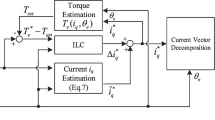Abstract
This paper presents a fault-tolerant brake torque controller for four-wheel-distributed braking systems with in-wheel motors and Electro-Mechanical Brakes (EMB). Mechanical and electrical faults can degrade the performance of the EMB actuators and, thus, their effects need to be compensated in vehicle dynamics level. In this study, the faults are identified as performance degradation and expressed by the gains of each actuator. Assuming the brake force distribution and the regenerative braking ratios, the over-actuated braking system is simplified into a two-input system. A sliding mode controller is designed to track the driver’s braking and steering commands, even if there exist faults in EMBs. In addition, adaptive schemes are constructed to achieve the fault-tolerant control in braking. The proposed controller and strategies are verified in the EMB HILS (Hardware-in-loop-simulation) unit for various conditions.
Similar content being viewed by others
References
Åström, K. J. and Wittenmark, B. (2013). Adaptive Control. Courier Corporation. Dover Publications, INC. Mineola, New York.
Gáspár, P., Szabó, Z. and Bokor, J. (2012). LPV design of fault-tolerant control for road vehicles. Int. J. Applied Mathematics and Computer Science 22, 1, 173–182.
Gillespie, T. D. (1992). Fundamentals of Vehicle Dynamics. Vol. 114. SAE International. USA.
Han, K., Kim, M. and Huh, K. (2012). Modeling and control of an electronic wedge brake. Proc. Institution of Mechanical Engineers, Part C: J. Mechanical Engineering Science 226, 10, 2440–2455.
Ho, L. M., Roberts, R., Hartmann, H. and Gombert, B. (2006). The electronic wedge brake-EWB. SAE Paper No. 2006-01-3196.
Hori, Y. (2004). Future vehicle driven by electricity and control-research on four-wheel-motored “UOT electric march II”. IEEE Trans. Industrial Electronics 51, 5, 954–962.
Hwang, W., Han, K. and Huh, K. (2012). Fault detection and diagnosis of the electromechanical brake based on observer and parity space. Int. J. Automotive Technology 13, 5, 845–851.
Jeong, Y. S., Sul, S. K., Schulz, S. E. and Patel, N. R. (2005). Fault detection and fault-tolerant control of interior permanent-magnet motor drive system for electric vehicle. IEEE Trans. Industry Applications 41, 1, 46–51.
Jonner, W. D., Winner, H., Dreilich, L. and Schunck, E. (1996). Electrohydraulic brake system-the first approach to brake-by-wire technology. SAE Paper No. 960991.
Line, C., Manzie, C. and Good, M. C. (2008). Electromechanical brake modeling and control: From PI to MPC. IEEE Trans. Control Systems Technology 16, 3, 446–457.
Mokhiamar, O. and Abe, M. (2004). Simultaneous optimal distribution of lateral and longitudinal tire forces for the model following control. J. Dynamic Systems, Measurement, and Control 126, 4, 753–763.
Mutoh, N. and Yahagi, H. (2005). Control methods suitable for electric vehicles with independently driven front and rear wheel structures. Vehicle Power and Propulsion, 2005 IEEE Conf., 638–645.
Németh, B., Gaspar, P., Bokor, J., Sename, O. and Dugard, L. (2012). Fault-tolerant control design for trajectory tracking in driver assistance systems. 8th Symp. IFAC on Fault Detection, Supervision and Safety of Technical Processes (Safeprocess) 8, 1, 186–191.
Rajamani, R. (2011). Vehicle Dynamics and Control. Springer Science & Business Media. New York.
Sakai, S. I., Sado, H. and Hori, Y. (1999). Motion control in an electric vehicle with four independently driven inwheel motors. IEEE/ASME Trans. Mechatronics 4, 1, 9–16.
Shtessel, Y., Edwards, C., Fridman, L. and Levant, A. (2014). Sliding Mode Control and Observation. Birkhäuser. New York.
Sul, S. K. (2011). Control of Electric Machine Drive Systems. Vol. 88. John Wiley & Sons. New Jersey, USA.
Wallmark, O., Harnefors, L. and Carlson, O. (2007). Control algorithms for a fault-tolerant PMSM drive. IEEE Trans. Industrial Electronics 54, 4, 1973–1980.
Wang, R. and Wang, J. (2011). Fault-tolerant control with active fault diagnosis for four-wheel independently driven electric ground vehicles. IEEE Trans. Vehicular Technology 60, 9, 4276–4287.
Yang, H., Cocquempot, V. and Jiang, B. (2010). Optimal fault-tolerant path-tracking control for 4WS4WD electric vehicles. IEEE Trans. Intelligent Transportation Systems 11, 1, 237–243.
Young, K. D., Utkin, V. I. and Ozguner, U. (1999). A control engineer’s guide to sliding mode control. IEEE Trans. Control Systems Technology 7, 3, 328–342.
Author information
Authors and Affiliations
Corresponding author
Rights and permissions
About this article
Cite this article
Kim, S., Huh, K. Fault-tolerant braking control with integerated EMBs and regenerative in-wheel motors. Int.J Automot. Technol. 17, 923–936 (2016). https://doi.org/10.1007/s12239-016-0090-1
Received:
Revised:
Accepted:
Published:
Issue Date:
DOI: https://doi.org/10.1007/s12239-016-0090-1




